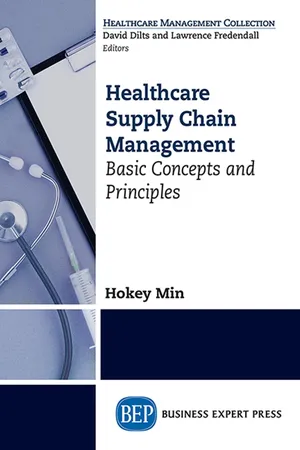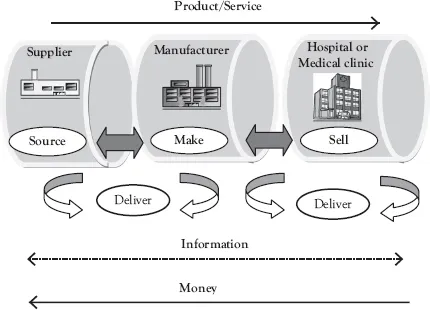![]()
CHAPTER 1
Essentials of Healthcare Supply Chain Management
In the United States, human life expectancy jumped from 68.2 years in 1950 to 78.7 years in 2011 (OECD 2013). By 2050, the U.S. life expectancy is expected to reach 88.5 years (Milken Institute 2013). As people live longer, the proportion of aging populations will continue to grow and the need for healthcare services will rise significantly. A growing need for more frequent and better healthcare services can overwhelm the current healthcare system, unless drastic measures can be taken to improve its efficiency and effectiveness. Given chronic shortages of healthcare workers, mounting healthcare operating expenses, and complex government mandates and regulations, we have very limited options to choose from to deal with the current and future healthcare crisis. In this book, we introduce the emerging concept of supply chain management as one of those viable options that can help us not only defuse the healthcare crisis, but also sustain the high level of healthcare productivity.
1.1 What Is Supply Chain Management?
Over the years, many healthcare organizations got engaged in the daily activities of acquiring required medical equipment and supplies, storing essential medicines, distributing medical necessities, and scheduling patient services without coordinating and synchronizing those activities. As these activities are treated as separate organizational functions, we may end up buying medical supplies and pharmacies far more than we need, keeping obsolete medical equipment and archaic technology, and underutilizing healthcare workers. That is to say, the lack of connectivity among these functions can lead to the suboptimization of organizational goals and create inefficiency by duplicating organizational efforts and resources. To capture the synergy of interfunctional and interorganizational integration and harmonization across the healthcare operations, we need to realize the strategic importance of planning, controlling, and designing a healthcare supply chain as a whole. Generally, a supply chain is referred to as an integrated system, which synchronizes a series of interrelated processes in order to: (1) create demand for products; (2) acquire raw materials and parts; (3) transform these raw materials and parts into finished products; (4) add value to these products; (5) distribute and promote these products to either retailers or end-customers; and (6) facilitate information exchange among various interrelated organization entities (e.g., suppliers, manufacturers, distributors, third-party logistics providers, and retailers) (Min and Zhou 2002). Its main objective is to enhance the operational efficiency, profitability, and competitive position of an organization (e.g., hospital) and its supply chain partners (e.g., pharmaceutical manufacturers, healthcare insurers including state healthcare exchanges). More concisely, supply chain management is defined as “the integration of key business processes from end-users through original suppliers that provide products, services, and information and add value for customers and other stakeholders” (Cooper et al. 1997b, 2). A supply chain is characterized by a forward flow of goods and services, a back-and-forth flow of information, and a backward flow of money (or capital) as illustrated by Figure 1.1.
Figure 1.1 Supply chain process
1.1.1 Traditional Versus New Ways of Managing Healthcare
To cope with financial challenges in the midst of economic crisis and budget cuts, many healthcare organizations made conscious efforts to reduce costs by laying-off healthcare workers, postponing investment in equipment and technology modernization, and improving the accuracy of demand forecasts for medical supplies and pharmaceuticals. Although it sounds plausible, this traditional way of saving healthcare costs can backfire because staff reductions through layoffs can exacerbate worker (especially nurse) shortages, the failure to upgrade necessary medical equipment and technology can undermine productivity, and a reliance on forecasts can increase risk and uncertainty associated with the volatile and unpredictable aspects (e.g., emergent care and massive disease outbreaks) of medical supplies and pharmaceuticals. Considering the aforementioned potential pitfalls of traditional cost saving methods, we need to come up with “more innovative and leaner” alternatives. These alternatives should be designed to enhance patient value by eliminating the sources of nonvalue adding activities such as “never events” (e.g., redundant medical procedures, unnecessary surgeries, excessive inventories of medical supplies, and obsolete drugs), administrative red-tapes, and opaque healthcare price mechanism.
One promising alternative that was put forward in the recent past is an adoption of supply chain principles. Put simply, supply chain principles aim to streamline all the healthcare processes related to sourcing needed medical supplies or pharmaceuticals, making healthcare products or creating healthcare services, marketing (selling) healthcare, and delivering healthcare products and services through the elimination of wasteful spending, investment, and activities. The supply chain principle is considered to be a new way of doing business in that it no longer relies heavily on forecasts, it fills the medical order on demand rather than forcing patients to follow the predetermined routine but unnecessary medical procedures, and it empowers patients and healthcare professionals to make appropriate healthcare decisions based on the accurate and timely provision of information throughout the entire healthcare processes.
1.1.2 Importance of Supply Chain Principles to Healthcare Management
As discussed earlier, a traditional healthcare management paradigm intends to react to unforeseen patient demand or healthcare service request on a push basis by building buffers such as the Intermediate Care Department for bed-blockers (individuals who occupy the hospital beds because they have no other suitable place to stay for their medical cares), the inventory of medicines (e.g., vaccines) or medical supplies (e.g., syringes) that can mitigate forecasting errors and hides demand planning problems. The traditional paradigm is also characterized by the sequential flow of information from one medical procedure to another. Since the sequential information flow would not give an organization an opportunity to synchronize its functional activities and would impair its visibility throughout the planning processes, the same hidden problems will recur and the vicious cycle of recurring problems will continue without ever addressing them. The best way to break this vicious cycle is to create a proactive system that would allow the organization to see the big picture of the healthcare processes and then analyze the impact of the whole healthcare processes on the organization-wide goals rather than the departmental and functional goals. For example, aggregating demand for the entire healthcare network would allow the Group Purchasing Organization (GPO) to increase its purchasing power or bargaining strength and thus exploit volume discount opportunities for the acquisition of medical supplies and drugs. In addition, centralized purchasing will help the healthcare organization standardize its purchasing practices and avoid duplicated purchases.
As such, to continuously improve healthcare processes, the traditional business paradigm should be replaced by the total system approach that can create a whole greater than the sum of its parts.
Therefore, the total systems approach is considered a major foundation for the supply chain concept. The total systems approach regards the supply chain as an entity that is comprised of interdependent or interrelated subsystems, each with its own provincial goals, but which integrates the activities of each segment so as to optimize the system-wide goals. To elaborate, the total systems approach is referred to as a holistic, integrated approach whereby the entire healthcare processes involving demand planning, purchasing, healthcare service scheduling (e.g., surgery, and nurse and doctor shift scheduling), distribution, and marketing are coordinated to make the best tradeoffs within them so as to achieve the optimal outcome for the whole system. For instance, the decision to create buffers to make healthcare services more readily available to patients will help reduce patient response time and subsequently improve healthcare service quality, but it would incur higher operating costs with a greater chance of extra capacity and idle resources. Without understanding such interdependence of the decision-making processes within the supply chain, the healthcare organization as a whole would continue to suffer from the downward spiral of declining productivity. That is to say, the total systems approach recognizes the fact that the decision made in one of the functions or departments can impact other functions or departments of the organization. As such, the total systems approach that is considered a major conceptual foundation for supply chain principles enables the healthcare organization to assess how changes in healthcare environments affect the healthcare organization’s across-theboard total costs and benefits.
1.1.3 Supply Chain Drivers for Healthcare Practices
Despite a high price tag of the healthcare systems in the United States, the United States ranks as one of the worst among the developed countries in terms of healthcare quality. This irony calls for dramatic healthcare reform, which includes the recent enactment of the Patient Protection and Affordable Care Act. Regardless of its intended purposes, healthcare reform is one of the most controversial subjects due to its inherent complexity and dynamics involving multiple stakeholders comprised of patients, their employers (or healthcare buyers and payers), healthcare service providers, insurers, and government entities regulating healthcare services. The moot points regarding healthcare reform often center around the people’s right to healthcare, affordability, quality, accessibility, rules and regulations, cost control, and the extent of public financing. Since each stakeholder has a different view of these moot points, it is difficult to establish common goals that would be beneficial to all interested parties. The absence of common goals is likely to obstruct the effort to build partnerships among the interested parties and then share information and resources among them. The inability to share information and resources among the healthcare stakeholders leads to duplicated processes and confusion that have contributed to healthcare inefficiency and ineffectiveness. To develop the common goals, healthcare stakeholders need to figure out what will be the major driving forces (drivers) behind today’s healthcare reform involving managerial revolution such as supply chain management. Using the fundamental framework proposed by Min and Zhou (2002), we can classify these drivers into four categories: (1) customer service initiatives, (2) monetary value, (3) information and knowledge transactions, and (4) risk elements.
1.1.3.1 Customer Service Initiatives
Though difficult to quantify, the ultimate goal of healthcare is patient satisfaction. Put simply, patient satisfaction is the degree to which patients are satisfied with the healthcare service received. The following list represents typical service elements in a healthcare supply chain.
• Service availability: As an integral part of the healthcare system, healthcare workers play an important role in making healthcare services available to patients when and where those services are needed. Without doctors or nurses, a patient cannot be treated. In spite of their crucial role, there has been a chronic shortage of healthcare workers. According to the World Health Organization (WHO), the world is currently short 7.2 million healthcare workers and will get worse with the expected shortage of 12.9 million healthcare workers by 2035 (Brooks 2013 Thomas et al., 2014). The question remains how disruptive the healthcare supply chain will be without a sufficient number of healthcare workforces and then how adversely healthcare worker shortages influence the quality of healthcare.
• Response time: Response time represents an important indicator of the healthcare service quality. Examples of response time include call-light response time (a speed of answering patient calls), emergency vehicle response time (interval between the time of emergency vehicle request and arrival), patient service time (the expected length of a patient visit), and patient wait time (the length of time interval between when the patient enters the clinic and the time the patient actually leaves the clinic).
1.1.3.2 Monetary Value
The monetary value is generally defined as a ratio of revenue to total cost. A healthcare system can enhance its monetary value through increasing revenue, healthcare coverage, and healthcare worker productivity, while reducing expenditures, service failures, and duplication. More specifically, the monetary value is categorized as follows:
• Asset utilization: Asset utilization can be estimated by several different metrics such as net asset turns (a ratio of total gross revenue to working capital),...

